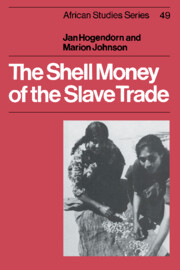Book contents
- Frontmatter
- Contents
- Maps
- Tables and chart
- Preface
- Introduction
- 1 The cowrie
- 2 The Maldive Islands
- 3 The Portuguese domination
- 4 The Dutch and English enter the trade (seventeenth century)
- 5 Prosperity for the cowrie commerce (eighteenth century)
- 6 Boom and slump for the cowrie trade (nineteenth century)
- 7 Collection, transport and distribution
- 8 Cowries in Africa
- 9 The cowrie as money: transport costs, values and inflation
- 10 The last of the cowrie
- Notes
- Bibliogaphy
- Index
10 - The last of the cowrie
Published online by Cambridge University Press: 12 October 2009
- Frontmatter
- Contents
- Maps
- Tables and chart
- Preface
- Introduction
- 1 The cowrie
- 2 The Maldive Islands
- 3 The Portuguese domination
- 4 The Dutch and English enter the trade (seventeenth century)
- 5 Prosperity for the cowrie commerce (eighteenth century)
- 6 Boom and slump for the cowrie trade (nineteenth century)
- 7 Collection, transport and distribution
- 8 Cowries in Africa
- 9 The cowrie as money: transport costs, values and inflation
- 10 The last of the cowrie
- Notes
- Bibliogaphy
- Index
Summary
The death of the cowrie currency brought painful economic change in the areas where the shells circulated and where they were produced. In West Africa, shell money might yet have had a long and important life as a subsidiary currency for very small purchases. But because of a combination of opposition by the colonial authorities and continuing twentieth-century inflation, that was not to be. The sad end of the shell money, and the unlucky result for the final holders of the now-useless stocks, are surveyed in the first part of this chapter.
Imports to West Africa came to an end several years before the shells actually ceased to be an important currency. Around 1900 the shell money was still circulating vigorously in much of its old zone, though certainly in decline. British silver coin had long since replaced cowries on the Gold Coast for all but the smallest market transactions, and in southern Nigeria, at least along the coast, the shells were being replaced, again by British silver. Francs were ousting cowries on the upper Niger and to the west of the river; in French territory by 1914 prices nearly everywhere were being quoted in francs even though the shells survived in many markets.
The attitude of the colonial governments was variably hostile. Doubtless influenced by the strong and almost universal belief in the rightness of fixed exchange rates, colonial officials attempted to fix rates between the cowrie and the metropolitan currency during the period just before the First World War. The French in particular did so avidly (the rate being typically 1,000 to the franc).
- Type
- Chapter
- Information
- The Shell Money of the Slave Trade , pp. 148 - 157Publisher: Cambridge University PressPrint publication year: 1986



